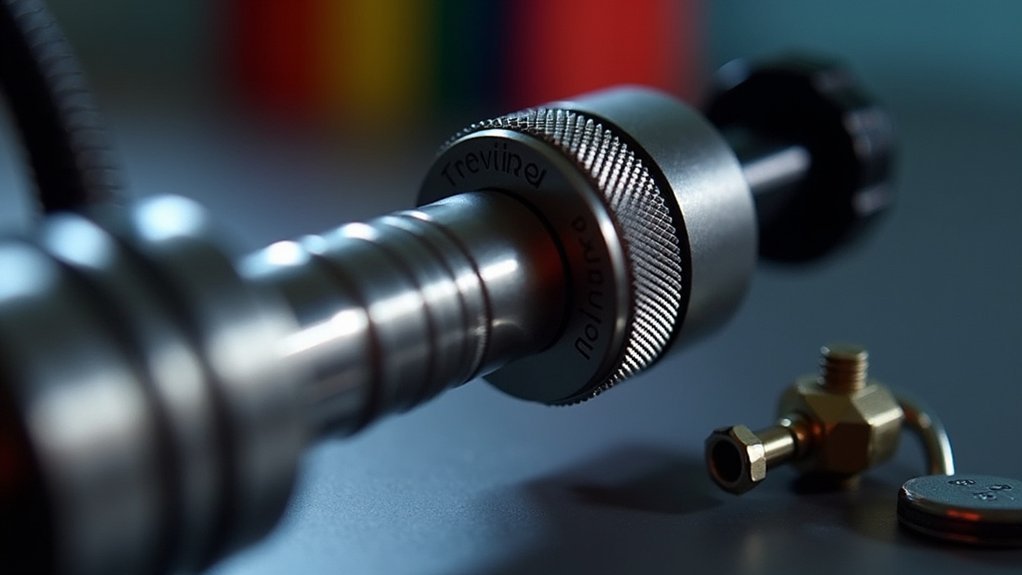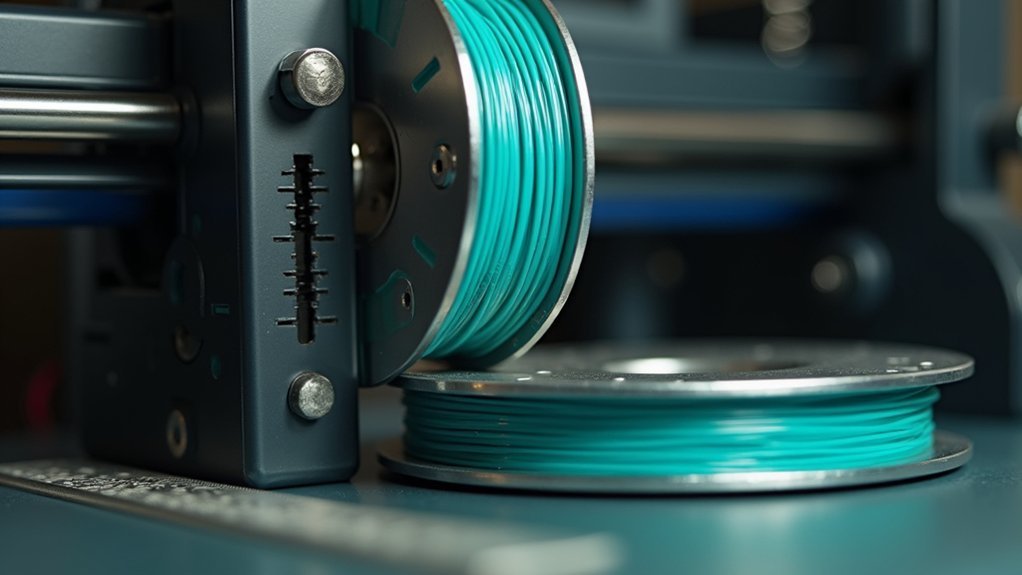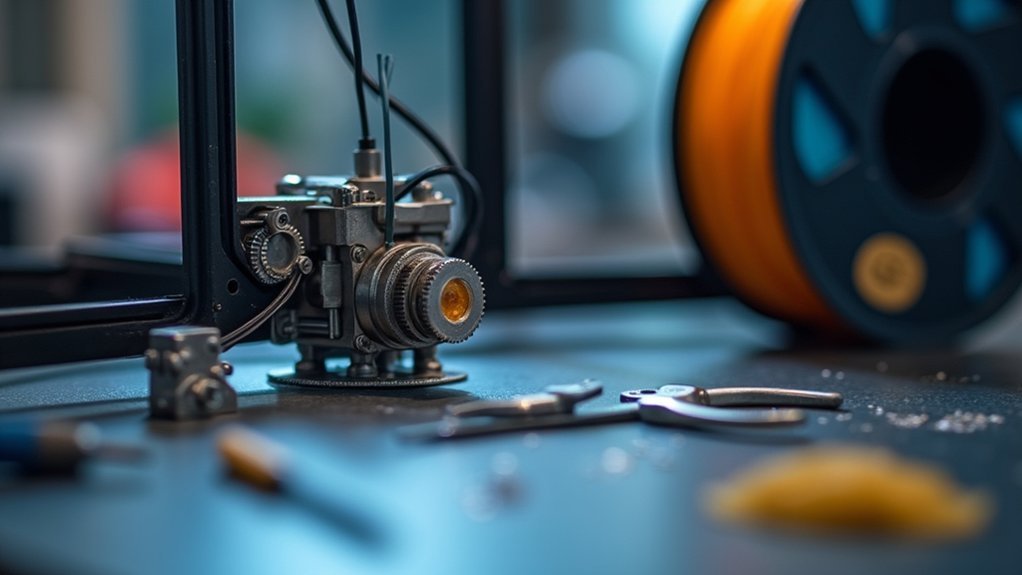You can fix direct drive extruder feeding issues by adjusting tension settings to prevent filament grinding, cleaning gear teeth of accumulated debris, and calibrating E-steps for accurate extrusion. Check your nozzle for clogs using cold pulls, verify filament path alignment, and guarantee consistent filament diameter within ±0.05mm. Don’t forget to lubricate moving components with PTFE-based oils and replace worn drive gears promptly. These targeted solutions will restore smooth feeding and reliable printing performance for your future projects.
Check and Adjust Extruder Tension Settings

One of the most critical factors in resolving direct drive extruder feeding problems is achieving the proper tension balance on your filament.
You’ll need to find the sweet spot where your drive gear creates slight indentations without crushing the material. If you notice grinding sounds or inconsistent extrusion, your extruder tension is likely insufficient, preventing proper filament engagement.
Conversely, excessive tension deforms the filament, increasing friction and reducing motor efficiency. Adjust tension based on your material type—flexible filaments require lighter tension to prevent grinding, while rigid materials need firmer grip.
Test your settings through manual extrusion trials and regularly clean your extruder components.
Clean Gear Teeth and Remove Filament Debris
Accumulated filament debris in your direct drive extruder’s gear teeth creates feeding inconsistencies that’ll frustrate even experienced makers.
You’ll need to clean these components regularly to maintain smooth operation and prevent extrusion problems.
Start by using a soft brush or compressed air to clear shavings and dust from the gear teeth.
Pay special attention to areas where filament enters the extruder and around the drive gear, as debris here causes grinding and reduces grip effectiveness.
Thoroughly inspect your filament path for blockages or snags that create resistance during feeding.
Establish a routine maintenance schedule for checking and cleaning extruder components.
This proactive approach greatly enhances printing reliability and quality while preventing costly downtime from preventable feeding issues.
Calibrate Extruder Steps Per Millimeter

Incorrect extruder steps per millimeter (E-steps) settings cause your direct drive extruder to push too much or too little filament, resulting in over-extrusion or under-extrusion issues that compromise print quality.
To calibrate extruder steps per millimeter accurately, mark 100mm of filament from your hot end entry point, then command your printer to extrude exactly 100mm. Measure the actual extruded length—if it’s less than 100mm, increase your E-steps value; if more, decrease it by 1-2 increments.
Mark 100mm of filament, extrude exactly 100mm, then measure actual length to adjust E-steps accordingly for proper calibration.
Most direct drive systems require 90-110 steps/mm, but this varies with stepper motor specifications and spring tension settings.
After adjusting E-steps, test print with rigid filaments to verify smooth extrusion without grinding filament or creating extrusion problems that affect printing quality.
Inspect and Clear Nozzle Clogs
Debris, burnt filament residue, and partially melted material often accumulate inside your nozzle, creating blockages that prevent smooth filament flow and cause feeding failures in direct drive extruders.
You’ll need to perform cold pulls regularly by heating your hotend, inserting filament, then pulling it out while cooling to clean the inner walls.
Use a needle or small wire to gently clear blockages without damaging the internal structure.
Monitor your filament temperature closely—maintain around 220°C for PLA’s first post and 215°C for subsequent layers to prevent material degradation.
Inspect your nozzle for wear regularly and replace damaged ones.
Remove and soak worn nozzles in appropriate solvents like acetone to dissolve stubborn residual material.
Verify Filament Path Alignment

When your direct drive extruder struggles with consistent feeding, misaligned filament paths often create the root cause of your printing problems.
Start by examining the entire filament route from spool to extruder entrance. You’ll quickly see any snags, loops, or sharp bends that restrict smooth movement.
A clear, unobstructed filament path from spool to extruder is essential for reliable 3D printing performance.
Next, verify the drive gear’s alignment with the PTFE tube. Even slight misalignment increases friction and causes feeding failures.
Check the PTFE tube itself for deformation, cracks, or wear that might create resistance or catch the filament.
Ensure your filament sits properly within the extruder mechanism and adjust the drive gear tension.
Too tight creates excessive pressure and grinding, while too loose prevents adequate grip for consistent feeding.
Test Different Temperature Settings
How can you determine if temperature issues cause your direct drive extruder’s feeding problems? Start by testing your current filament at different temperatures in 5°C increments. For PLA, begin around 210-220°C, while flexible filaments like TPU work better at 195-205°C to prevent grinding.
If you’re experiencing under-extrusion, increase temperature by 5°C to improve filament flow. However, excessive heat causes stringing and oozing.
Monitor your nozzle temperature closely during printing—fluctuations beyond +/- 1°C create extrusion inconsistencies and potential clogs. Conduct test prints to identify the best temperature range for your specific filament brand.
Remember that filament quality affects ideal temperatures: lower-quality materials often need higher heat for consistent extrusion, while premium filaments perform better at lower temperatures.
Examine Filament Quality and Diameter Consistency
Your filament’s quality and diameter consistency directly impact feeding performance in direct drive extruders.
Start by measuring the diameter at multiple points along the filament using calipers—you’ll want consistency within ±0.05mm of the specified size.
Poor-quality filament with diameter variations or moisture contamination can cause grinding, jamming, or inconsistent extrusion that’ll frustrate your printing efforts.
Check Diameter Tolerance
One of the most overlooked causes of direct drive extruder feeding problems stems from inconsistent filament diameter tolerance.
You’ll need to guarantee your filament stays within ±0.05 mm of the specified diameter for reliable extrusion. Variations beyond this range cause inconsistent feeding and potential clogging.
Use calipers to regularly measure your filament diameter, checking multiple points along the spool. A micrometer provides even more precise measurements to reveal irregularities that affect extruder performance.
When diameter’s inconsistent, your extruder gears can’t maintain proper grip—they’ll either slip on undersized filament or crush oversized material.
High-quality filament adheres to strict manufacturing tolerances, considerably reducing jam risks and improving print quality.
Don’t compromise on filament quality; it’s foundational to preventing feeding issues.
Assess Material Quality
Beyond diameter measurements, material quality greatly impacts your direct drive extruder’s performance. High-quality filament from reputable brands maintains better consistency and contains fewer defects, considerably reducing clogs and feeding problems.
You’ll want to conduct thorough visual inspections for defects like kinks, knots, or surface irregularities that can obstruct smooth feeding into your extruder.
Store your filament in a dry environment to prevent moisture absorption, which weakens the material and causes brittleness or poor extrusion quality.
Use calipers to measure diameter at multiple points along the filament—quality material should stay within ±0.02 mm of the specified size. Consistent diameter ensures proper flow through your nozzle, while variations cause grinding, under-extrusion, and feeding issues that’ll frustrate your printing process.
Lubricate Moving Components and Bearings
Maintaining proper lubrication of your direct drive extruder’s moving components prevents friction-related feeding issues that can plague even well-calibrated printers.
You’ll want to use lightweight lubricants like PTFE or silicone-based oils that won’t attract dust and debris. Before applying lubricant, clean all moving parts thoroughly, removing any filament debris or dust that could compromise effectiveness.
Apply lubricant sparingly to gears and bearings, focusing specifically on metal-to-metal contact points. Over-application can cause slippage or contaminate your filament path, creating new problems.
You should periodically check lubrication status, as components typically need re-lubrication after extensive printing sessions or specific operating hours. This proactive maintenance approach guarantees smoother filament feeding, improved extrusion consistency, and extends your extruder’s lifespan considerably.
Perform Cold Pull Cleaning Method
When persistent clogs compromise your direct drive extruder’s performance, the cold pull cleaning method offers one of the most effective solutions for restoring ideal filament flow.
Heat your hotend to 220°C for PLA, then insert filament and let it sit for several seconds. Allow slight cooling before executing a swift pulling motion to extract debris-laden material. The filament’s thermal expansion grips contaminants during this process, effectively clearing your nozzle pathway.
| Before Cold Pull | After Cold Pull |
|---|---|
| Frustrating print failures | Smooth, reliable extrusion |
| Wasted filament and time | Perfect first layers every time |
| Clogged, inconsistent flow | Crystal-clear nozzle pathway |
Repeat this process until extracted filament emerges completely clean. Always verify your extruder cools down afterward to prevent PTFE tube deformation or hotend damage.
Replace Worn Drive Gears and Hardware
While cold pulls address nozzle blockages, worn drive gears create feeding problems at the source. You’ll need to inspect your drive gears for wear and tear, as damaged teeth can’t grip filament properly.
Replace any stripped or worn gears immediately to restore consistent extrusion.
Check your tensioning hardware and springs for fatigue or breakage. Worn tension mechanisms won’t apply adequate force to the filament, causing slippage and inconsistent feeding.
When replacing components, invest in high-quality gears made from durable materials – they’ll enhance your extruder’s longevity and performance.
Don’t forget other associated hardware like the feeder assembly and bolts. Regular monitoring and replacement of these components maintains effective operation and prevents future feeding problems from developing.
Frequently Asked Questions
How to Unclog a Direct Drive Extruder?
Heat your hotend to filament temperature, then perform a cold pull with nylon filament. Clean the nozzle with a wire brush, check for obstructions, and replace the nozzle if necessary.
How Do You Fix Extruder Skipping?
You’ll fix extruder skipping by adjusting tension properly, clearing nozzle clogs through cold pulls, using quality filament, cleaning drive gears regularly, and ensuring adequate stepper motor power settings for your material.
Why Does My Filament Stop Feeding?
Your filament stops feeding due to nozzle clogs, incorrect extruder tension, temperature issues, or dirty drive gears. Check for blockages, adjust tension settings, verify temperatures, and clean your extruder components regularly.
How to Fix Inconsistent Extrusion?
Check your extruder tension first—it shouldn’t crush filament. Clean gear teeth regularly, adjust nozzle temperature for your filament type, inspect filament quality, and verify drive gear alignment to fix inconsistent extrusion.





Leave a Reply